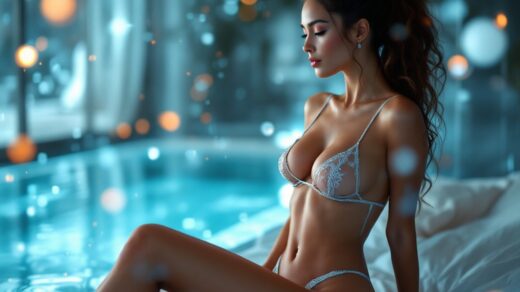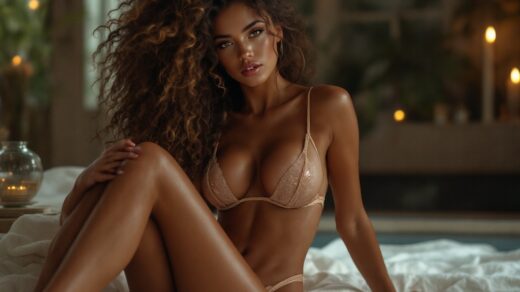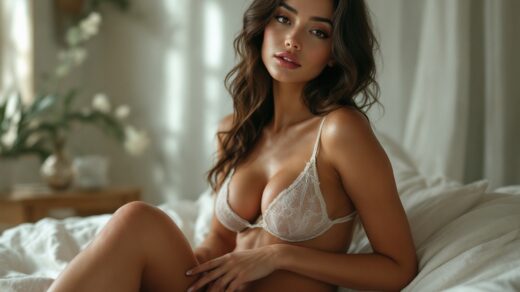The amalgamation of artificial intelligence and artistic flair has dramatically transformed the art world in ways never seen before. A particularly vivid domain undergoing this metamorphosis is the sphere of erotic art. Conventional erotic categories have historically functioned as reflections of societal views on sexuality, tracing their roots through centuries of artistic exploration and representation. Today, with the ascent of AI-generated art, we are encountering a fresh interpretation that defies norms and reconfigures boundaries. Equipped with an ever-expanding arsenal of tools, AI technology unlocks a new realm of erotic expression that commands our attention and introspection. This article aims to delve into the captivating intersection of AI-generated artistry and established erotic genres, highlighting the reciprocal influences these vibrant forms exert on one another and how they enhance our comprehension of desire and creativity.
Comprehending AI Art
To fully appreciate the importance of AI art, we must explore its definition and the technological frameworks propelling this emerging field. AI art encompasses a vast array of creative outputs that are either generated or enhanced by algorithms and machine learning methodologies. By programming computers to discern patterns, artists can harness AI’s capabilities to create anything from digital illustrations to interactive exhibits. The sphere of AI art incorporates neural networks that simulate human cognitive processes and generative adversarial networks (GANs) specialized in producing images often indistinguishable from those created by human hands. As AI technology advances, so too does the artistic complexity and emotional resonance of its creations. This evolution stirs provocative questions surrounding the essence of creativity and the artist’s role.
What Constitutes AI Art?
- AI art pertains to artworks developed with the assistance of artificial intelligence technologies.
- It encompasses various artistic mediums, including visual arts, music, and literature.
- The inception of AI art can be traced back to the 1960s, yet significant advancements have surged recently.
- Core technologies propelling AI art include neural networks and machine learning algorithms.
AI’s Ascension in Creative Arenas
The advent of AI in multifarious creative domains has dramatically reoriented the artistic creation landscape. From literature to music, AI’s integration has burgeoned, facilitating unique collaborations between machine intellect and human innovation. Artists now commonly employ AI as a creative ally, blending their visions with software capable of analyzing extensive databases of styles and techniques. This cooperative dynamic fosters an environment ripe for inspiration in surprising fashions. Yet, the intrinsic human touch remains an essential aspect, igniting debates surrounding authorship and authenticity in art. Next, we will dive into the traditional erotic genres that laid the groundwork for current explorations.

Traditional Erotic Genres: A Concise Overview
Traditional erotic genres encompass a vibrant array of artistic expressions within literature and visual arts that celebrate human sexuality. These forms have significantly evolved since their inception, mirroring societal shifts and values over time. The erotic artistic sphere ranges from ancient sculptures that evoke sensuality to present-day literature that examines intimate relationships. The intricate nature of traditional erotic genres often invites interpretations that extend beyond simple titillation, posing profound inquiries about desire, power dynamics, and human connections. Grasping these intricacies lays the groundwork for appreciating how AI engages with these venerable forms. The following list outlines key elements of traditional erotic art:
- Subtlety and Symbolism: A multitude of traditional pieces utilize metaphor and allegory to articulate erotic themes.
- Cultural Context: Representations of love and sexuality reflect the prevailing societal values of their time.
- Diversity of Mediums: Erotic expression manifests in various forms, including paintings, sculptures, literature, and performance art.
Historical Background
From the renowned masterpieces of Ancient Greece to the daring works of the Renaissance, the history of erotic art is as diverse as it is captivating. Each period lends its distinctive viewpoint on sexuality and the human experience, often shaped by contemporary philosophies and ideologies. In modern times, this rich historical tapestry continues to influence artistic expressions that challenge boundaries and break societal taboos. Examining how different historical eras engaged with erotic expression unveils the cultural significance of themes present in today’s AI-generated content. This progression paves the way for a dialogue between traditional and modern forms that AI art complicates and enriches.
| Era | Characteristics of Erotic Art | Notable Figures/Works |
|---|---|---|
| Ancient Greece | Focus on beauty, the human form, and mythology | Kouros, Terra Cotta figures |
| Renaissance | Emphasis on humanism and nature; classical nudity celebrated | Sandro Botticelli’s “The Birth of Venus” |
| 20th Century | Investigation of psychological and social dynamics; embrace of sexual liberation | Gustav Klimt, Édouard Manet |
The Convergence of AI Art and Traditional Erotic Genres
AI-generated art has not only established its place in the art world but has also begun to significantly alter the terrain of traditional erotic genres. The convergence of these two forms showcases a vibrant dialogue where innovation intertwines with tradition. Distinct representations of erotic themes through AI concentrate on aesthetics while simultaneously challenging prevailing narratives. For instance, collaborative efforts among artists utilizing AI can yield evocative imagery addressing contemporary discussions around sexuality and identity. Furthermore, AI’s engagement with traditional erotic genre tropes allows for fresh perspectives and dialogues regarding desire, intimacy, and individuality.

Groundbreaking Interpretations
Significantly, some AI artists are investigating timeless elements, providing modern viewpoints on enduring themes. By fusing historical techniques with cutting-edge technology, these creators produce works that provoke curiosity and demand deeper exploration. The interactive dimension of AI art adds yet another layer, enabling viewer engagement that traditional mediums often lack. Audiences are encouraged to delve into their interpretations of these works, engaging in discussions about personal desire and emotional responses. This collaborative interaction between AI technology and the audience serves to democratize erotic expression, inviting diverse interpretations that honor both the time-honored and the novel.
Ethical Considerations in AI Erotic Art
While the emergence of AI art in erotic genres is promising, it concurrently spurs vital ethical inquiries regarding ownership and representation. Issues related to copyright and the rights of AI creators remain largely uncharted territory. As AI art gains prominence, a pivotal question arises: Who holds the rights to artworks produced by AI? This dialogue is particularly salient in the erotic art arena, where human models and real individuals have conventionally shaped artistic expression. The discourse extends to concerns regarding consent and the representation of bodies in AI-generated pieces, especially as algorithms may struggle to grasp the intricate subtleties surrounding gender and identity.
Ownership and Copyright Matters
- Who possesses the rights to AI-generated art? The legal framework is presently ambiguous concerning ownership of AI creations.
- Implications for artists: Conventional artists must navigate adapting to this newly emerging reality of co-creativity with machines.
- Ethical dilemmas: Creating erotic art through AI necessitates sensitivity around consent and the portrayal of identity.
Conclusion
In conclusion, the interplay between AI-generated art and traditional erotic genres offers a remarkable opportunity for investigation and discourse. This intersection not only reshapes the artistic arena but also challenges us to rethink the implications of desire, identity, and creativity in our contemporary era. By comprehending the foundations of traditional erotic expression, we can truly appreciate how AI art pushes limits and beckons us to critically examine representations of sexuality. Ultimately, the evolution of these genres through AI technology marks an exhilarating chapter in the ongoing story of art, one that harmoniously weaves together human experience and technological innovation.
FAQ
- What is AI art? AI art refers to artworks generated with the aid of artificial intelligence technologies, often employing algorithms to create visual or musical expressions.
- How does AI art impact traditional erotic genres? AI art introduces innovative techniques and depictions, generating fresh interpretations and discussions about erotic themes that challenge or enrich conventional narratives.
- Are there ethical issues related to AI in erotic art? Yes, matters concerning ownership, consent, and representation in AI-generated erotic artworks present significant ethical dilemmas that must be tackled as this art form evolves.
- Can AI art supplant traditional erotic art? While AI art presents new creative avenues, it is improbable that it will entirely replace traditional erotic art, as the human element of creativity and emotional connectivity remains essential to artistic expression.


